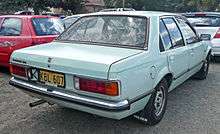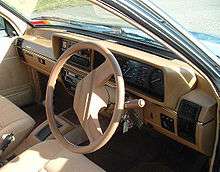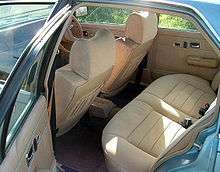Holden Commodore (VB)
The Holden Commodore (VB) is a mid-size car that was produced by the Australian manufacturer Holden, from 1978 to 1980. It was the first iteration of the first generation of the Holden Commodore.
| Holden Commodore (VB) | |
|---|---|
.jpg) | |
| Overview | |
| Manufacturer | Holden (General Motors) |
| Production | October 1978 – March 1980 |
| Assembly | Australia: Dandenong, Victoria; Pagewood, New South Wales New Zealand: Trentham |
| Body and chassis | |
| Class | Mid-size car |
| Body style | 4-door sedan 5-door station wagon |
| Platform | GM V platform |
| Related | Opel Rekord E Opel Senator Vauxhall Carlton Opel Commodore C |
| Powertrain | |
| Engine | 2.85 L Red I6 (64 kW (86 hp)) 3.3 L Red I6 (66 kW (89 hp)) 4.2 L Red V8 (87 kW (117 hp)) 4.2 L Red V8 (96 kW (129 hp), dual exhaust) 5.0 L Red V8 (114 kW (153 hp)) |
| Transmission | 4-speed manual 3-speed Tri-Matic automatic 3-speed THM350 automatic (5.0 L V8) 3-speed THM400 automatic (5.0 L V8) |
| Dimensions | |
| Wheelbase | 2,668 mm (105.0 in) |
| Length | 4,705–4,729 mm (185.2–186.2 in) |
| Width | 1,722 mm (67.8 in) |
| Height | 1,371 mm (54.0 in) |
| Chronology | |
| Predecessor | Holden HZ |
| Successor | Holden Commodore (VC) |
The car was officially launched on 26 October 1978 with showrooms receiving the first examples on 13 November 1978. Production of the VB only lasted seventeen months, the shortest reign of any Commodore. The VB Commodore was effectively the successor of the Holden HZ, although most models in that series continued to be produced until the introduction of the facelifted VC Commodore on 30 March 1980.
95,906 units of the VB Commodore were manufactured during the car's lifespan, and during 1979 the VB became Australia's number one selling car. Also in 1979, the VB won Wheels Car of the Year award, with the car being praised in the media for its value for money and engineering sophistication.
Design
The VB Commodore was loosely based on the 1977 Opel Rekord E bodyshell but with the front grafted on from the Opel Senator to accommodate the larger Holden six-cylinder and V8 engines, giving it a similar appearance to the Opel Commodore, the Vauxhall Viceroy, sold in the UK and the Chevrolet Commodore, sold in South Africa. Overall, the body was strengthened substantially to withstand the harsh conditions of the Australian outback. Total cost of development is reported to be over A$110 million.[1]
The Commodore represented a major shift in thinking for Holden since it was significantly smaller than the previous full-size family car, the Holden Kingswood, but visually similar in size to the mid-size Torana / Sunbird sedans. It essentially came about in response to the 1973 oil crisis and the need to produce more fuel-efficient cars. Holden, hedging their bets, initially built the Commodore alongside the other two established body styles, until the Torana was dropped in mid-1979, with only the Sunbird surviving into mid-1980 following release of the updated VC Commodore. The VB was available in three specification levels: Commodore, Commodore SL, and Commodore SL/E. A station wagon variant – not available in SL/E form – was released on 24 July 1979, hitting showrooms on 6 August 1979. It featured a large cargo area and an easy access one-piece lift-up tailgate. As the wagon-specific sheet metal had to be imported from Germany (from the Rekord), the wagon suffered from inevitable component differences from the sedan, confirmed by the separate keys for the ignition system and rear door.[2][3]
The OHV engines were largely carried over from the Kingswood: a 2.85-litre 64-kilowatt (86 hp) straight-six, 3.3-litre 71-kilowatt (96 hp) straight-six, 4.2-litre 87-kilowatt (117 hp) V8, which was also available with dual exhausts to produce 96 kilowatts (129 hp) of power, and a 5.0-litre 114-kilowatt (153 hp) V8, which in dual exhaust form was rated at 125 kilowatts (168 hp). The engine blocks on these motors were painted red and are therefore commonly referred to as the Red motors. The VB was also available with either a four-speed manual transmission or a three-speed Trimatic automatic transmission, or the Turbo-Hydramatic 350/400 automatic transmission with the 5.0-litre V8.
Specification levels

_SL_station_wagon_(20189467463).jpg)
- All V8's came with power steering. On the station wagon, there was no 15x6 inch alloy wheels option.
Commodore
The Commodore was the baseline variant, and was available as a sedan or station wagon. The sedan was priced from A$6,513.
- The VB Commodore standard features included:[4]
- 2.85-litre 64 kW (86 hp; 87 PS) Red I6 engine
- 4-speed manual transmission
- Featured body colour tail panel
- Silver finish on instrument surrounds
- Vinyl trim
- Steel wheels
- The VB Commodore standard optional included:[5]
- 3.3-litre 66-kilowatt (89 hp) Red I6 engine
- 4.2-litre 87-kilowatt (117 hp) Red V8 engine
- 3-speed automatic transmission
- Air conditioning
- Corded cloth interior
- Power steering
- European Pack which incorporated:
- 3.3-litre 66-kilowatt (89 hp) Red I6 engine
- Full instrumentation
- Four wheel discs
- Headlight washers / wipers
- 15 inch alloy wheels
- Sport Pack on manuals only, which incorporated:
- 4.2-litre 87-kilowatt (117 hp) Red V8 engine
- Full instrumentation
- Four wheel discs brakes
- Headlight washers/wipers
- 15x6 inch alloy wheels
Commodore SL
The Commodore SL was the mid-spec variant, and was available as a sedan or station wagon. The sedan was priced from A$7,813.
- The VB Commodore SL standard features included:[6]
- 3.3-litre 71 kW (95 hp; 97 PS) Red I6 engine
- 3-speed automatic transmission
- Bright door mouldings
- Chrome wheeltrim rings
- Corded velour cloth trim
- Extra gauges (volts & oil pressure)
- Featured vertical accent bars on the grill
- Inertia reel seatbelts for the outer rear passengers
- Rear centre armrest
- Rosewood dash finish
- Silver tail panel
- Twin exterior mirrors
- Variable intermittent speed wipers
- Steel wheels
- The VB Commodore SL optional features included:[7]
- 4.2-litre 87 kW (117 hp; 118 PS) Red V8 engine
- Air conditioning
- Power steering
- Full instrumentation
- Four wheel discs brakes
- Headlight washers/wipers
- 4spd manual transmission
- Vinyl upholstery
- 15x6 inch alloy wheels
Commodore SL/E


The Commodore SL/E was the top of the line variant. It was available as a sedan only, and was priced from A$10,513.
- The VB Commodore SL/E standard features included:[8]
- 4.2-litre 87-kilowatt (117 hp) Red V8 engine
- 3-speed automatic transmission
- Air conditioning
- Black door frames and tail panel
- Blacked out grille
- Burr walnut dash
- Chrome exhaust
- Chrome door handles
- Extended rear bumpers
- Blaupunkt stereo radio cassette player which incorporated:
- Electric aerial
- Headlight wiper/washers
- Power Steering
- Reading lights
- Retractable seatbelts
- Reversing mirror
- Tachometer
- Velour trim and cut pile carpet
- 4 wheels disc brakes
- 15x6 inch alloy wheels
- The VB Commodore SL/E optional features included:[9]
- 3.3 L 71-kilowatt (89 hp) Red I6 engine available as a reduced cost option
- 5.0 L 114-kilowatt (153 hp) Red V8 engine which incorporated:
- Turbo-Hydramatic 350 or 400 transmission
- 4-speed manual transmission
- Central locking
- Power windows
Motorsport
The VB Commodore featured heavily in Australian motorsport in the latter part of 1979 and through most of 1980.
In 1979 the factory backed Holden Dealer Team entered a three-car VB Commodore team in the 20,000-kilometre (12,000 mi) Repco Round Australia Trial which started and finished at the Royal Melbourne Showgrounds and travelled clockwise around the country over some of the most inhospitable terrain imaginable. The team Commodore's were powered by the 3.3-litre straight-six Holden Red motor rather than the more powerful V8 due to their much lighter weight. Anxious to prove the then new cars reliability, the cars were perfectly prepared and finished first, second and third. Lead HDT driver Peter Brock won the event along with co-drivers Matt Phillip and Noel Richards. Brock has cited this event as his career highlight as it was an event in which many motor racing experts throughout Australia, as well as the media, did not believe he would do well in despite his previous rally and rallycross exploits.
With new regulations for Group C Touring car racing introduced by the Confederation of Australian Motor Sport in 1980 which forced teams to use low emission engines, the HDT (by now owned by Brock and with actual support from Holden dealers after Holden had pulled out of racing at the end of 1979) had been secretly testing a VB Commodore as its replacement for the A9X Torana. The new regulations saw that the Holden's racing 5.0-litre V8 engine had a drop in power from 1979's 380 hp (283 kW) to approximately 300 hp (224 kW). However, the new regulations also saw to it that the HDT had arguably the only race ready car for the 1980 Australian Touring Car Championship. Peter Brock won the championship in his VB Commodore, winning four of the eight rounds while claiming pole position at each and every round. 1979 ATCC winner Bob Morris also won a round of the championship driving his Craven Mild Racing VB Commodore.
Brock then won the 1980 CRC 300 at Sydney's Amaroo Park circuit before upgrading to the VC Commodore by the Hang Ten 400 at Sandown Raceway. The VB's final placing in an Australian touring car race was a strong third place by Ian "Pete" Geoghegan and Paul Gulson at the 1980 Hardie-Ferodo 1000 at Bathurst (Brock and Jim Richards won their third straight Bathurst 1000 in their VC Commodore).
As of 2015, the VB remains only one of two Commodore models (along with the VN) not to have won the Bathurst 1000.
References
- Bebbington, Terry (2009). 60 Years of Holden. Padstow, New South Wales: Haynes Manuals. ISBN 1-876953-58-6.
- Davis, Tony; Kennedy, Alistair; Kennedy, Ewan (February 2007). "The Holden Heritage – 13th Edition (Part Two)" (PDF). GM Holden. pp. 79–80. Archived from the original (PDF) on 16 September 2010.
- Kenwright, Joe (29 July 2006). "Crossing the Lion". CarPoint. Archived from the original on 27 August 2006. Retrieved 16 June 2007.
- Bebbington (2009), p. 77. "[W]agon models joined the line-up in July 1979 [...] The sheetmetal unique to the wagon body style was imported from Germany".
- "Holden VB Commodore Standard Features". Unofficial Holden Commodore Archive. Retrieved 27 February 2007.
- "Holden VB Commodore Optional Features". Unofficial Holden Commodore Archive. Retrieved 27 February 2007.
- "Holden VB Commodore SL Standard Features". Unofficial Holden Commodore Archive. Retrieved 27 February 2007.
- "Holden VB Commodore SL Optional Features". Unofficial Holden Commodore Archive. Retrieved 27 February 2007.
- "Holden VB Commodore SL/E Standard Features". Unofficial Holden Commodore Archive. Retrieved 27 February 2007.
- "Holden VB Commodore SL/E Optional Features". Unofficial Holden Commodore Archive. Retrieved 27 February 2007.
External links
| Wikimedia Commons has media related to Holden Commodore (VB). |
- 100 kilometres per hour (62 mph) Holden VB Commodore crash test. This test was conducted on 9 June 1992 by the Roads and Traffic Authority (RTA) as part of a test series to commission the Crashlab test facility at Rosebery, New South Wales, Australia. The test was of the facility's drive system, not the actual car which had the tail shaft removed, 300 kilograms (660 lb) of sand ballast placed in the footwells and boot and a 75 kilograms (165 lb) ballast dummy placed on the rear seat. This was supposed to represent a worst-case scenario.
- Golden Holdens : VB Commodore (1978–1980)
- Holden Model History – Holden Commodore – VB Series November 1978 – March 1980
- The Commodore Info Page – Holden Commodore – VB Series November 1978 – March 1980
- The Unofficial Holden Commodore Archive – VB Commodore
- The Unofficial Holden Commodore Archive – VB Commodore Specifications
- Unique Cars and Parts: Holden Commodore VB